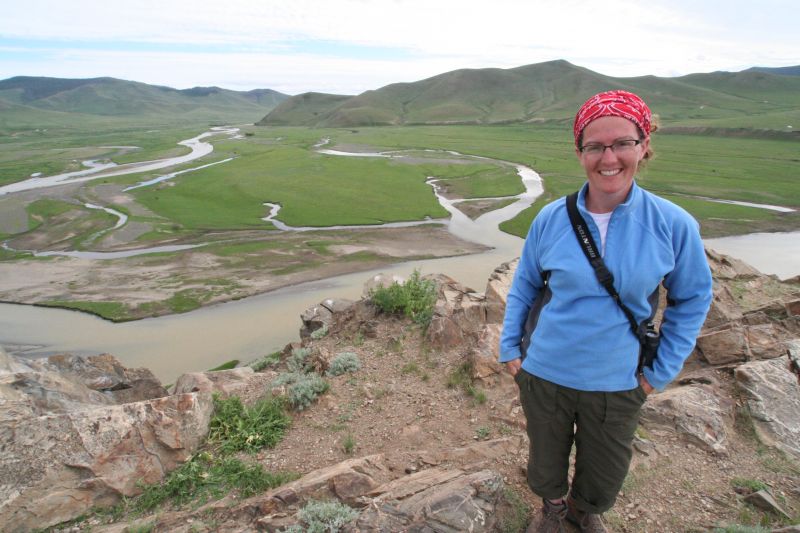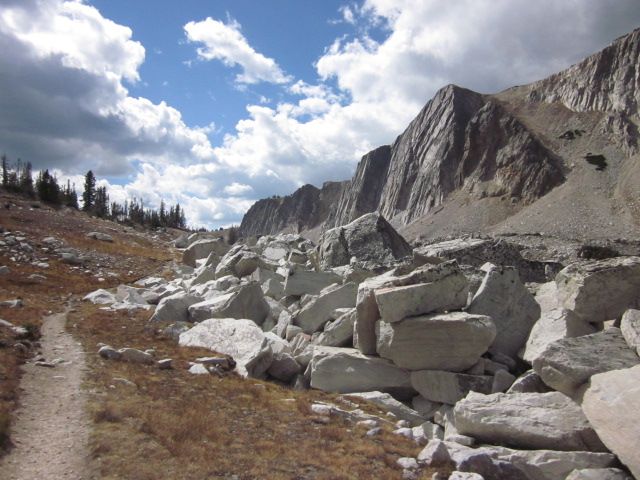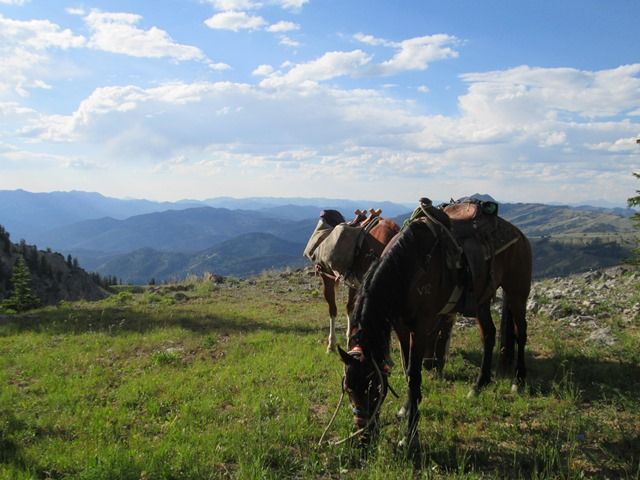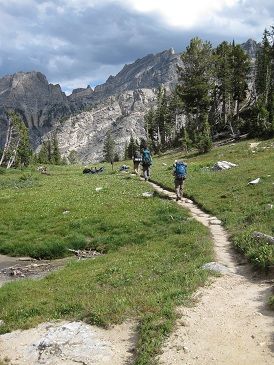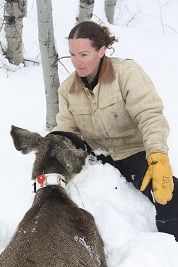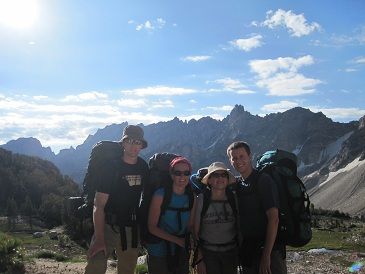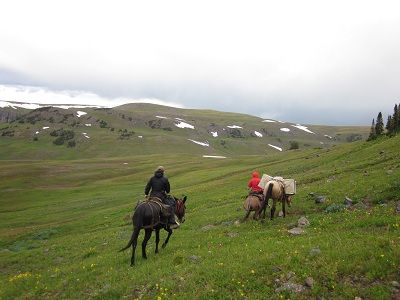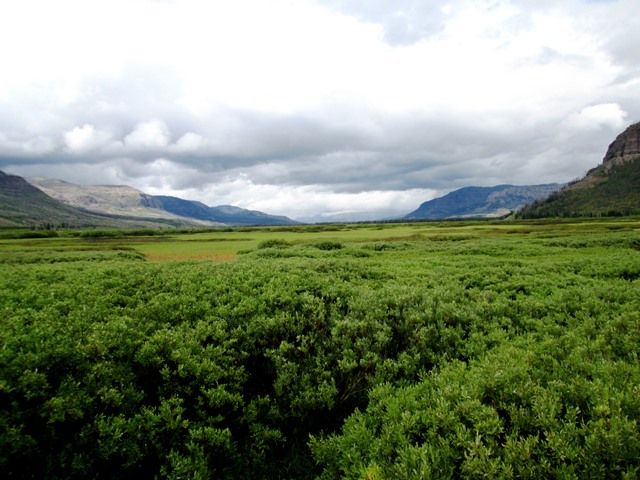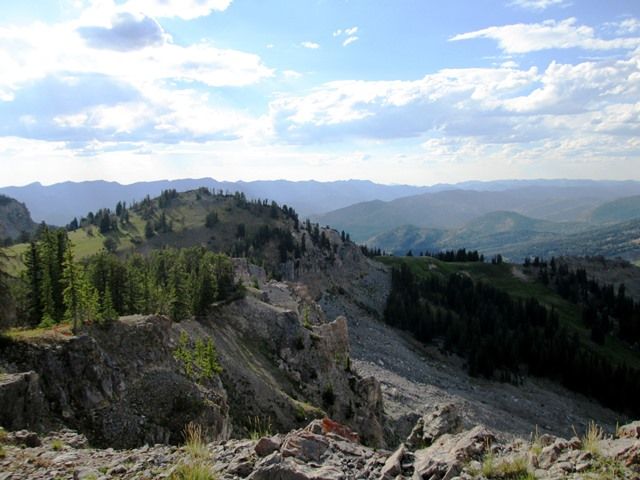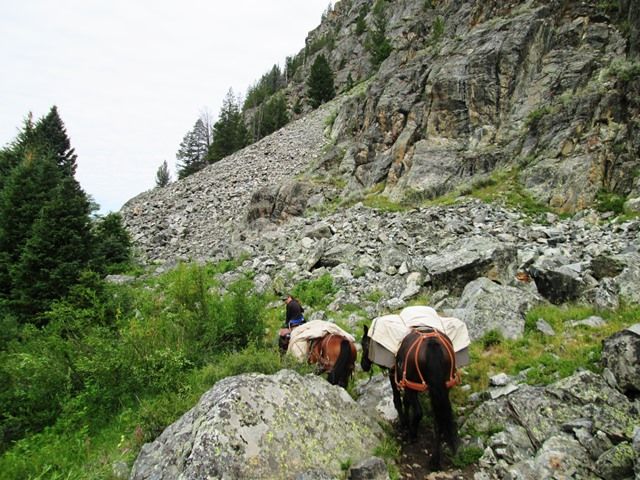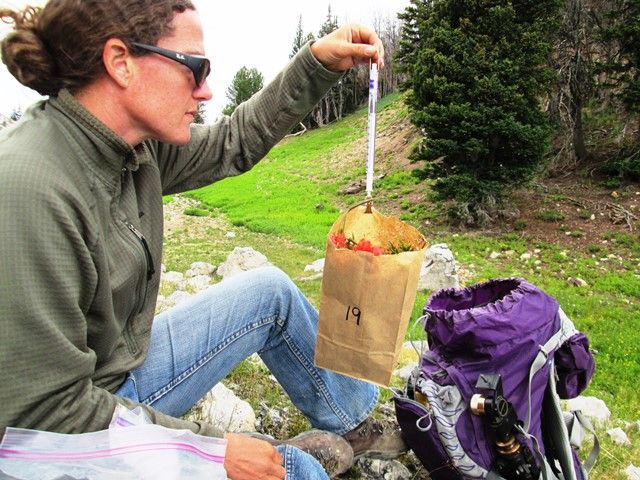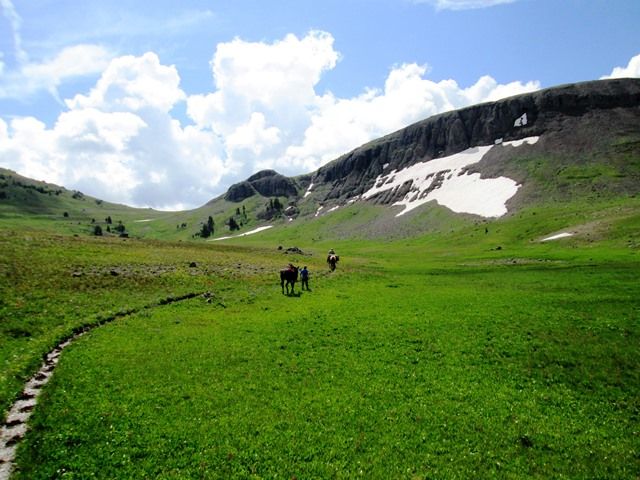Embere has a BS in Wildlife Ecology & Management, an MS in Ecology & Evolutionary Biology and a PhD in Ecology. She is fascinated by the incredibly diverse ways in which organisms deal with environmental challenges. In particular, she researches the degree to which animals adjust to human-induced environmental change. Her current work examines the ecological and demographic effects of climate change, and how wildlife may respond to a changing environment through exploitation of unique habitats or behaviors. Results of her research will contribute to enhanced management programs that can minimize biodiversity loss under rapid climate change. For additional information, click here.
When she is not engaged in research, Embere enjoys traveling the backcountry via foot, horse, skis or kayak. Exploring western landscapes offers both a lot of fun, and a chance to see wildlife-conservation challenges first-hand.
Download CV
Gallery
Professional Preparation and Appointments
EDUCATION
Ph.D. Ecology, University of Wyoming
Dissertation Title: “Behavioral plasticity and resilience of a montane mammal in a changing climate”
M.S. Ecology & Evolutionary Biology, Iowa State University
Thesis Title: “Avian nest success and snake abundance in restored and remnant grasslands in northwestern Iowa”
B.S. Wildlife Ecology & Management/Spanish, University of Wisconsin-Stevens Point
PROFESSIONAL APPOINTMENTS
Research Scientist (Postdoctoral)
Wyoming Cooperative Fish & Wildlife Research Unit, University of Wyoming
Graduate Research Assistant (Ph.D. Candidate)
Wyoming Cooperative Fish & Wildlife Research Unit, University of Wyoming
Research Director
Conservation Research Center, Teton Science Schools
Research Faculty
Conservation Research Center, Teton Science Schools
Research Assistant
Iowa Cooperative Fish & Wildlife Research Unit, Iowa State University
Publications
PEER-REVIEWED
*indicates mentored student
Hall, L. Embere and A. Chalfoun. 2018. What to eat in a warming world: Do increased temperatures necessitate hazardous duty pay? Oecologia. 186: 73-84 DOI: 10.1007/s00442-017-3993-2
Riginos, C., M. Graham, M. Davis, A. Johnson, A. May, K. Ryer and E. Hall. 2018. Wildlife warning reflectors and white canvas reduce deer-vehicle collisions and risky road-crossing behavior. Wildlife Society Bulletin. DOI: 10.1002/wsb.862
Jakopak, R*., E. Hall and A. Chalfoun. 2017. Organizing the pantry: cache management improves quality of overwinter food stores in a montane mammal. Journal of Mammalogy. 98: 1674-1681 DOI: 10.1093/jmammal/gyx124
Beever, E., E. Hall, J. Varner, A. Loosen, J. Dunham, M. Gahl, F. Smith and J. Lawler. 2017. Behavior as a mechanism for coping with climate change. Frontiers in Ecology and the Environment. 15: 299-308 DOI: 10.1002/fee.1502. (Cover article).
Hall, L. Embere, A. Chalfoun, E. Beever and A. Loosen. 2016. Microrefuges and the occurrence of thermal specialists: Implications for wildlife persistence amidst changing temperatures. Climate Change Responses. DOI: 10.1186/s40665-016-0021-4
Hall, L. Embere. 2005. Clay-colored sparrows nesting in Dickinson County. Iowa Bird Life. 74:172-173 (Invited).
Hall, L. Embere and A. Chalfoun. Behavioral plasticity modulates temperature-related constraints on foraging time for a montane mammal. In revision. Journal of Animal Ecology
Hall, L. Embere, J. Carlisle, L. Sanders, T. McDonald and A. Chalfoun. A plastic home-building strategy mediates potential thermal risk for sedentary prey. Submitted. Behavioral Ecology
Hall, L. Embere and R. Koford. Grassland snake habitat use and response to road edges in a fragmented landscape. In prep. Wildlife Biology
TECHNICAL REPORTS & THESES
Wyoming Game & Fish Dept (Contributing author). 2017. American pika (Ochotona princeps). In State Wildlife Action Plan. Wyoming Game & Fish Dept., Cheyenne, WY, USA.
Wyoming Game & Fish Dept (Contributing author). 2017. Mountain grasslands and alpine tundra. In State Wildlife Action Plan. Wyoming Game & Fish Dept., Cheyenne, WY, USA.
Hall, E. 2017. Behavioral plasticity and resilience of a montane mammal in a changing climate. Dissertation. University of Wyoming, Laramie, WY, USA.
Hall, E. and A. Chalfoun. 2017. Understanding changing climate conditions in alpine habitats: a test of wildlife responses, limits and plasticity. Final Status Report. (Wyoming Game & Fish Dept.). Wyoming Cooperative Fish & Wildlife Research Unit, Laramie, WY, USA.
Riginos, C., M. Davis, M. Graham, A. Johnson, and E. Hall. 2015. Effects of wildlife warning reflectors (“deer delineators”) on wildlife-vehicle collisions in central Wyoming. Final Report. (Wyoming Dept. of Transportation). Submitted on behalf of Teton Science Schools. Jackson, WY, USA.
Conservation Research Center of Teton Science Schools (Contributing author). 2013. Mule deer (Odocoileus hemionus) movement and habitat use patterns in relation to roadways in northwest Wyoming. Final Report. (Wyoming Dept. of Transportation). Jackson, WY, USA.
Hall, E. 2012. Songbirds of the Rocky Mountains. Science Report. (Earthwatch Institute). Conservation Research Center of Teton Science Schools, Jackson, WY, USA.
Hall, E. 2012. Understanding mule deer (Odocoileus hemionus) movement and habitat use patterns in relation to roadways in northwest Wyoming. Final Interim Report. (Wyoming Department of Transportation). Conservation Research Center of Teton Science Schools, Jackson, WY, USA.
Hall, E., J. McCabe, A. Johnson and S. Fagan. 2011. Monitoring Avian Productivity and Survivorship in Jackson Hole: 1991-2011. Interim Report. (Wyoming Game & Fish Department). Conservation Research Center of Teton Science Schools. Jackson, WY, USA.
Selected Presentations
*indicates mentored student
Hall, E. and A. Chalfoun. 2017. Behavioral plasticity buffers temperature constraints on foraging time for a montane mammal. Oral presentation. The Wildlife Society Wyoming Chapter
Carlisle, J., E. Hall, A. Chalfoun, K. Carr and L. Sanders. 2017. Sage Thrashers raise the roof: Does an augmented nest structure conceal the nest from predators, or improve its microclimate? Oral presentation. The Wildlife Society Wyoming Chapter
Hall, E. and A. Chalfoun. 2017. What to eat in a warming world: Do increased temperatures necessitate hazardous duty pay? Oral presentation. The Wildlife Society
Hall, E. and A. Chalfoun. 2016. What to eat in a warming world: altering forage preferences may buffer climate stress. Oral presentation. The Wildlife Society Wyoming Chapter
Hall, E., A. Chalfoun, E. Beever and A. Loosen. 2016. Microrefuges and thermal specialists: Understanding wildlife persistence amidst changing temperatures. Oral presentation. 13th Greater Yellowstone Biennial Scientific Conference
Hall, E., A. Chalfoun, E. Beever and A. Loosen. 2015. Microrefuges and the occurrence of temperature-limited species in highly seasonal environments. Oral presentation. The Wildlife Society Wyoming Chapter
Jakopak, R.*, E. Hall and A. Chalfoun. 2015. Understanding the architecture of overwinter food caches in a montane mammal. Poster presentation. The Wildlife Society Wyoming Chapter
Hall, E., A. Chalfoun, E. Beever and A. Loosen. 2015. The importance of microrefugia: Essential resource or irrelevant detail? Oral presentation. 3rd Conference of the North American Pika Consortium
Riginos, C., E. Hall, M. Graham, S. Sundaresan and K. Krasnow. 2014. Mule deer movements, habitat use and road ecology along the Jackson wildland-urban interface. Oral presentation. Jackson Hole Wildlife Symposium
Hall, E., K. Murphy and A. Chalfoun. 2013. Snow cover, forage availability and heat stress. Pika habitat use in a changing environment. Oral presentation. The Wildlife Society Wyoming Chapter
Riginos, C., K. Krasnow, E. Hall, M. Graham, S. Sundaresan, T. McDowell, B. Hammond, D. Brimeyer and G. Fralick. 2013. Mule deer movement and habitat use in relation to roadways. Oral presentation. The Wildlife Society Wyoming Chapter
Hall, E., A. Loosen, E. Beever, K. Murphy, L. Yandow and L. Oles. 2012. Investigating American pika habitat selection in the southern Greater Yellowstone Ecosystem. Oral presentation. The Wildlife Society Annual Conference
Beever, E., S. Dobrowski, E. Hall and A. Loosen. 2012. Incorporating ecohydrologic variables into modeling of patterns of montane-mammal distribution and abundance. Oral presentation. The Wildlife Society Annual Conference
Beever, E., S. Dobrowski, J. Wilkening, E. Hall and S. Wolff. 2012. Variability in microclimates of mountain ranges of western North America, and its effect on distribution and trend of alpine mammals. Oral presentation. MtnClim Conference
Beever, E., S. Dobrowski, E. Hall and A. Loosen. 2012. Temporally shifting determinants of distribution and abundance of American pikas, and behavioral plasticity ‘softening’ ecological-niche boundaries. Invited oral presentation. Society for Conservation Biology Annual Conference
Beever, E., S. Dobrowski, E. Hall and A. Loosen. 2012. Incorporating ecohydrologic variables into modeling of patterns of montane-mammal distribution and abundance. Oral presentation. The Wildlife Society Montana Chapter
Hall, E., S. Dwinnell, L. Work, P. Hallsten, G. Fralick, D. Brimeyer, S. Dewey, B. Hammond, and S. Fagan. 2011. Understanding mule deer movements and responses to roadways in northwest Wyoming. Poster presentation. The Wildlife Society Wyoming Chapter
Alexander, P., J. Newby, M. Cuthill, H. Quigley, D. Thompson and E. Hall. 2011. Preliminary results testing the efficacy of noninvasive monitoring techniques to estimate mountain lion abundance in the southern Greater Yellowstone Ecosystem. Poster presentation. The Wildlife Society Wyoming Chapter
Hall, E., J. McCabe and C. Smith. 2010. The effects of human development on songbird populations along a riparian corridor in Jackson Hole, Wyoming. Poster presentation. The Wildlife Society Annual Conference
Hall, E., J. McCabe, M. Karp, C. Smith and D. Wachob. 2010. The effects of human development on avian populations along riparian corridors in Jackson Hole, Wyoming. Oral presentation. The Wildlife Society Wyoming Chapter
Hall, E., E. Wise, K. Murphy and S. Wolff. 2010. Understanding precipitation variability in the Upper Snake River Watershed. Oral presentation. North American Pika Conference
Loosen, A., E. Hall, K. Murphy, E. Beever and S. Wolff. 2010. Investigating American pika occupancy in the southern Greater Yellowstone Ecosystem. Oral presentation. The Wildlife Society Wyoming Chapter
Scholarships & Fellowships
2016
The Wildlife Society (Wyoming Chapter) Graduate Student Scholarship
L. Floyd Clarke Graduate Scholar
University of Wyoming, Academic Affairs, Summer Doctoral Augmentation Award
Program in Ecology Travel Award
2015
University of Wyoming, Academic Affairs, Summer Doctoral Augmentation Award
2014
Reed W. Fautin Memorial Scholarship
Haub School of Envrionment & Natural Resources Student Research & Creative Activities Grant
Program in Ecology Summer Stipend Award
Biodiversity Institute Occupancy Shortcourse Tuition Remission Award
2013
L. Floyd Clarke Graduate Scholarship
Program in Ecology Travel Award



